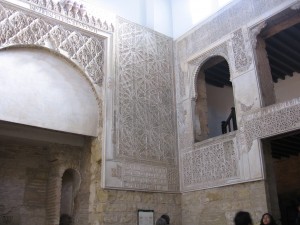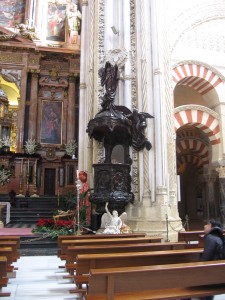The Andalusia area of Spain takes its name from the Arabic Al-Andalus, reflecting seven centuries of Muslim rule beginning in the 7th century CE. However, this portion of southern Spain was likewise shaped by Phoenicians, Greeks, Romans and Visigoths prior to the Moors, as well as the native Iberians, not to mention the Christians who took control after the Muslims. Sephardic Jewry likewise made a mark. These disparate influences uniquely shaped Andalusia, coming as they did in waves, but also remaining side-by-side in distinctive ways. As the author John Gill writes in Andalucia, A Cultural History,
If we are looking for a deeper thread running through Andalucia, from its prehistory to the modern days, it is a place as an open, indeed at some points empty, space where numerous cultures found room to thrive, expand, or simply flee from trouble elsewhere…

My husband and I recently returned from a 10 day train and car trip through Andalusia, our first, and the mixture of influences, and the relative tolerance of differing cultures that marks much of the area’s history, was the most profound discovery of the trip. We visited Seville, Arcos de la Frontera, Ronda, Granada, Ubeda, Cordoba, and Toledo and Madrid (these last two cities too central to be considered Andalusia).
Every place, as well the train and car travel between locations, conveyed the interweaving of cultures. A prime example is the magnificent Mezquita in Cordoba. Currently a Catholic cathedral, it was once a medieval mosque. Originally it was a Visigoth Christian church. Signs of all three uses are evident, most strikingly the arcaded hypostyle hall begun by Abd ar-Rahman I with hundreds of columns of marble, jasper, onyx, and granite made from pieces of the previous Roman temple. The columns are crowned with distinctive red and white arches. In the middle of this Muslim atmosphere is a monumental Catholic cathedral nave constructed during the Renaissance, after the Christian reconquest.
Also in Cordoba is the oldest Jewish synagogue in Spain, built in the 14th century, one of the four synagogues remaining in Spain that predate the expulsion of the Jews in 1492 by Ferdinand and Isabella (two are in Toledo, one in Hijar). The synagogue was built in the Mudejar style by Muslim craftsmen. It is tiny, a stark contrast with the Mezquita, but it nonetheless evidences the cultural blending so evident in Andalusia. Its presence in the Juderia, Cordoba’s old Jewish quarter, is also quite poignant, given the destructive effects the Christian reconquest had on the Jews and Muslims in the area at the time..

There are many more awe-striking historical sites in Andalusia, but architecture is not the only evidence of cultural intermingling. The food we encountered was delicious and varied, prepared and served by Andalusians eager to respond to our questions and obvious interest, and likewise tangible evidence of the historical influences of the region. An example is gazpacho, the thick cold soup generally consisting of tomatoes, onions, garlic, olive oil, vinegar, and stale bread, recognized as originating in Andalusia. We enjoyed it several times, and it was always a little different. According to Steven Raichlen in a 1989 article in The New York Times online,
[Cookbook author Paula] Wolfert believes the dish came to Spain with the Moors, who occupied the Iberian Peninsula from the 8th to the 12th centuries. The word gazpacho comes from an Arabic word for ”soaked bread,” Ms. Wolfert wrote.
 One food historian, Raymond Sokolov, hypothesized in a June 1988 article in Natural History magazine that gazpacho reached Spain much earlier, with the arrival of the Romans, who liked to eat bread soaked in vinegar. He noted that the only surviving Roman cookbook included salad recipes in which vinegar-soaked bread and olive oil were central elements. Mr. Sokolov said the term gazpacho may come from the pre-Roman word caspa, meaning residue or fragment.
One food historian, Raymond Sokolov, hypothesized in a June 1988 article in Natural History magazine that gazpacho reached Spain much earlier, with the arrival of the Romans, who liked to eat bread soaked in vinegar. He noted that the only surviving Roman cookbook included salad recipes in which vinegar-soaked bread and olive oil were central elements. Mr. Sokolov said the term gazpacho may come from the pre-Roman word caspa, meaning residue or fragment.
We benefited from many wonderful food and wine recommendations from local Spaniards. High points included the Taberna Salinas at Tunidores 3 in Cordoba and Taberna Embrujo on Calle Santa Leucadia in Toledo. My husband did an admirable job of pre-booking our hotels, and two particularly wonderful ones were the Hotel Montelirio at Tenorio 8 in Ronda and Las Casas de la Juderia at Calle Tomas Conde 10 in Cordoba. Our rental car that we picked up in the Seville train station and returned at the Madrid airport we organized Carrentals.co.uk (a car rental comparison search engine) and was great value. While the roads (even the small ones!) in Spain were quite nice and easy to navigate even for non-expert Spanish speakers like us, our Garmin Nuvi 1370 navigation system brought from home was indispensable. Lastly, we had a wonderful train ride from Madrid to Seville on the AVE Renfe train, Preferente class.
About the Author: Gail Robillard is a fourth grade teacher who was a trial attorney in a previous life. She notes that in both professions you have to think on your feet, but 9 year-olds are more fun and they laugh at her jokes. Based in Southern California, she is an experienced Mexico traveler, as well as several other locales in North America, but didn’t traverse any oceans until 2006 when she traveled to Scotland, England, and Wales. Since then she’s enjoyed Italy, Ireland, and Spain, as well as two trips to Israel and Jordan.

thanks to share awe-striking historical sites in Andalusia.
Hi Gail,
I adore your account of the “place as an open, indeed at some points empty, space where numerous cultures found room to thrive, expand, or simply flee from trouble elsewhere…”
Having rambled the scrubby hills of Andalusia for two months in 2010, I appreciate your deep and eloquently-worded descriptions. I learned stuff here! The origins of gazpacho, the order of religious dominance, the materials used to construct a medieval mosque. Thank you for a most enlightening read.
Wishing you happy and safe travels always and all ways,
~Josie
So interesting..we have visited andalucia last year (Sevilla, Ronda, Tarifa, Algeciras, Gibraltar, Cordoba, Granada..) within 7 days and it was one of the best vacations for us (in spite of rainy weather). I enjoyed reading some of the historical facts, really surprised about the Gaspacho =) I thought I had been eating something really spanish and there you go, arabic origins
Lovely article!